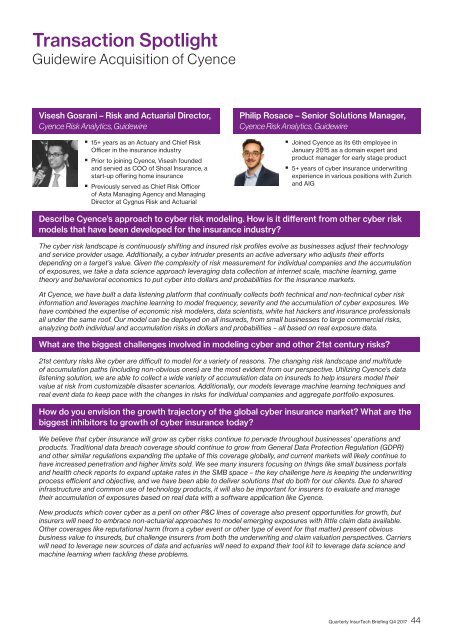quarterly-insurtech-briefing-q4-2017
You also want an ePaper? Increase the reach of your titles
YUMPU automatically turns print PDFs into web optimized ePapers that Google loves.
Transaction Spotlight<br />
Guidewire Acquisition of Cyence<br />
Visesh Gosrani – Risk and Actuarial Director,<br />
Cyence Risk Analytics, Guidewire<br />
• 15+ years as an Actuary and Chief Risk<br />
Officer in the insurance industry<br />
• Prior to joining Cyence, Visesh founded<br />
and served as COO of Shoal Insurance, a<br />
start-up offering home insurance<br />
• Previously served as Chief Risk Officer<br />
of Asta Managing Agency and Managing<br />
Director at Cygnus Risk and Actuarial<br />
Philip Rosace – Senior Solutions Manager,<br />
Cyence Risk Analytics, Guidewire<br />
• Joined Cyence as its 6th employee in<br />
January 2015 as a domain expert and<br />
product manager for early stage product<br />
• 5+ years of cyber insurance underwriting<br />
experience in various positions with Zurich<br />
and AIG<br />
Describe Cyence’s approach to cyber risk modeling. How is it different from other cyber risk<br />
models that have been developed for the insurance industry?<br />
The cyber risk landscape is continuously shifting and insured risk profiles evolve as businesses adjust their technology<br />
and service provider usage. Additionally, a cyber intruder presents an active adversary who adjusts their efforts<br />
depending on a target’s value. Given the complexity of risk measurement for individual companies and the accumulation<br />
of exposures, we take a data science approach leveraging data collection at internet scale, machine learning, game<br />
theory and behavioral economics to put cyber into dollars and probabilities for the insurance markets.<br />
At Cyence, we have built a data listening platform that continually collects both technical and non-technical cyber risk<br />
information and leverages machine learning to model frequency, severity and the accumulation of cyber exposures. We<br />
have combined the expertise of economic risk modelers, data scientists, white hat hackers and insurance professionals<br />
all under the same roof. Our model can be deployed on all insureds, from small businesses to large commercial risks,<br />
analyzing both individual and accumulation risks in dollars and probabilities – all based on real exposure data.<br />
What are the biggest challenges involved in modeling cyber and other 21st century risks?<br />
21st century risks like cyber are difficult to model for a variety of reasons. The changing risk landscape and multitude<br />
of accumulation paths (including non-obvious ones) are the most evident from our perspective. Utilizing Cyence’s data<br />
listening solution, we are able to collect a wide variety of accumulation data on insureds to help insurers model their<br />
value at risk from customizable disaster scenarios. Additionally, our models leverage machine learning techniques and<br />
real event data to keep pace with the changes in risks for individual companies and aggregate portfolio exposures.<br />
How do you envision the growth trajectory of the global cyber insurance market? What are the<br />
biggest inhibitors to growth of cyber insurance today?<br />
We believe that cyber insurance will grow as cyber risks continue to pervade throughout businesses’ operations and<br />
products. Traditional data breach coverage should continue to grow from General Data Protection Regulation (GDPR)<br />
and other similar regulations expanding the uptake of this coverage globally, and current markets will likely continue to<br />
have increased penetration and higher limits sold. We see many insurers focusing on things like small business portals<br />
and health check reports to expand uptake rates in the SMB space – the key challenge here is keeping the underwriting<br />
process efficient and objective, and we have been able to deliver solutions that do both for our clients. Due to shared<br />
infrastructure and common use of technology products, it will also be important for insurers to evaluate and manage<br />
their accumulation of exposures based on real data with a software application like Cyence.<br />
New products which cover cyber as a peril on other P&C lines of coverage also present opportunities for growth, but<br />
insurers will need to embrace non-actuarial approaches to model emerging exposures with little claim data available.<br />
Other coverages like reputational harm (from a cyber event or other type of event for that matter) present obvious<br />
business value to insureds, but challenge insurers from both the underwriting and claim valuation perspectives. Carriers<br />
will need to leverage new sources of data and actuaries will need to expand their tool kit to leverage data science and<br />
machine learning when tackling these problems.<br />
Quarterly InsurTech Briefing Q4 <strong>2017</strong> 44


